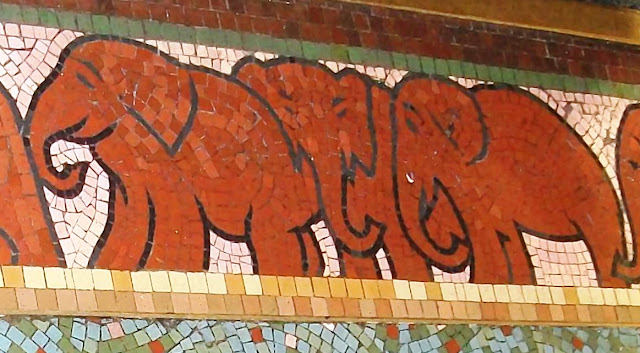The old Auckland City Council Rubbish Destructor, Victoria Park. Image from Wikipedia.
From the
Auckland Star, 27 October 1931.
The little electric motor lorries which collect rubbish from city shops and offices, and from the suburbs every day are common sights in the streets, so commonplace that nothing is thought of them and their work. Rubbish is merely put in tins by caretakers and householders and forgotten. It is supposed to be waste in the sense that it serves no useful purpose, but some of the material that goes into those tins is far from being rubbish. It is waste in quite another sense of the word. The queer odds and ends that are picked out of the so-called rubbish before it is condemned to the flames would fill a section in a museum of oddities.
"The carelessness of people is amazing," said Mr J Mathieson, officer-in-charge of transport and sanitation at the Auckland City Council destructor, after seeing his men rake over some five tons of an agglomeration of rubbish in search for missing articles. "They lose rings and banknotes, and jewellery and invoices, and false teeth and cutlery with careless abandon."
One day, he said, just as the rubbish from a particular cart was about to be tipped into the furnaces, a lady, clad in night attire and a wrap, burst into the destructor premises with the sad tale of the loss of a ring valued at £150. The men got to work, searched through piles of papers and carrot ends and tins and rotten fruit -- and they found the ring. Another few minutes and it would have been too late. While the lady had been preparing dinner the evening before she had taken the ring off and put it aside on a newspaper. When she finished preparing potatoes and pumpkin she wrapped the peelings in the paper ansd threw the parcel into the rubbish tin, ring and all. Some hours later she remembered.
Another hurried visit the destructor people had from a lady was occasioned by the loss of four £5 notes. To see the great heaps of all manner of rubbish piled there by the ton, is to wonder how four litrtle greeny-grey slips of paper could possibly be found. Yet they were restored to her.
One man lost some money in notes and made post haste to the destructor. After the staff had raked over a hopper full of rubbish (a hopper is a large steel container sloping away to the furnace) and had to admit their failure, the man cheerfully produced the money from the bottom of his pocket. "And that is typical of many cases," Mr Mathieson added. "We are put to no end of trouble, and then the missing article turns up. One woman rang up in a great state telling us that she thought she had dispatched some cricket pads to our care. She had, and we found them. They have been here ever since. That was about six months ago.
"I could fill up the humour columns in any newspaper with tales about men and women who have lost their false teeth. We are told how the teeth are put down 'just for a minute,' and how they are gone when they are again looked for. 'Someone always takes them,' they tell us, and puts them into the rubbish tin, I suppose."
Spoons, knives and forks are so common that the men by this time take no notice of them. One reputable householder was making an investigation for sundry missing articles, including a very old silver fork, and sheer chance led him to the dustbin. A meal had just been finished, but he did not connect that with the disappearance of the fork. On looking in the bin he found not merely the mkissing articl;e, but a perfectly good silver knife. In the family there were several juvenile members. Looking back through the years, when other articles broken or lost in other ways have been forgotten, he is inclined to attribute to the rubbish tin the steady depletion noticeable in his cutlery canteen.
Mr Mathieson admits that sheer hard luck was the lot of one man. He was a coal and firewood merchant, who had brought to the destructor a load of sawdust to be burned. He saw it sliding through the hopper to the incinerator, and then as he looked again he saw, too late, his coat sliding with it. The garment had £20 in notes and silver in it. When he saw the silver again it was melted into a streaky mess. The notes he never saw again. Once the carefulness of a shopkeeper was almost his undoing. It was on Christmas Eve and he was just about to leave his shop. He did not like to leave the takings of a heavy day in his till, so he put it in a box, put the lot in the dustbin, and then covered the box with some rubbish. He went home satisfied. The next working day he arrived at the office late, and found that the cleaner had been there before him, and zealous in her duties had thrown all the "rubbish" into the cart. Mr Mathieson received another visitor, who went away much relieved.
"The waste that goes on in the city must be tremendous," continued Mr Mathieson, "particularly with regard to food. We burn tons of potatoes and carrots and bread. And quite good things are thrown away, articles which could easily be repaired."
Though the destructor is the place where dirt and rubbish of all kinds collects, the premises are remarkably clean. The floors are free from dust, which is noteworthy seeing that the furnaces are never out. The whole place has a spick and span air.






































